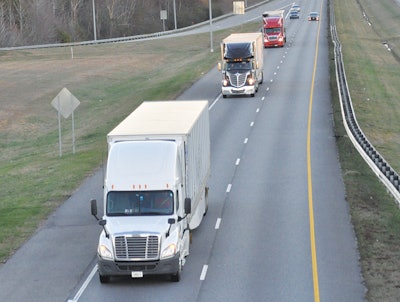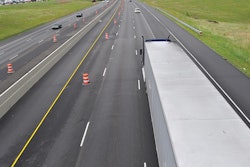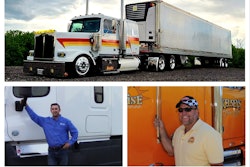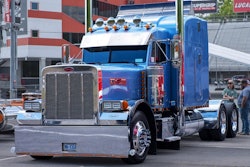PARTNERS IN BUSINESS TABLE OF CONTENTS »

There’s more to earnings than pay per mile
Most owner-operators leased to larger carriers are paid on a per-mile basis or a percentage of revenue per load. The per-mile basis is most prevalent among larger fleets, percentage at smaller. Pay per mile tends to dominate discussions about pay because it is easier to measure, and pay per mile often is wrongly used as the deciding factor in the decision about leasing to a carrier.
While pay per mile can be a vital factor, it’s not a cure for every ill. Nor does it mean a big settlement check is coming your way. Why? Because pay per mile always must be considered in balance with gross revenue. Gross revenue is the total amount paid to you by a carrier. It can include flat mileage pay, mileage pay that varies by length of haul, percentage of revenue pay, loading/unloading pay, detention pay, stop in transit pay, fuel surcharge, toll or scale reimbursement, etc.
In the following example, Carrier 1 pays a dollar per mile and pays the owner-operator a fuel surcharge and for unloading. Carrier 2 pays 70 percent of the revenue of the load, but no other expenses. Which carrier would you work for?
COMPARING DIFFERENT METHODS OF PAYMENT

Load from Stillwater, Oklahoma, to Jacksonville, Florida – 1,120 miles
Carrier No. 1 pays by the mile:
Mileage pay = 1,120 miles @ $1 per mile = $1,120
Unloading pay = $45
Fuel surcharge of 33 cents per mile = $370
Gross revenue to driver = $1,535
Gross pay to driver = $1,535 divided by 1,120 miles = 1.37 cents per mile
Carrier No. 2 pays percent of revenue:
$2,032 gross revenue to carrier on load
Percent of revenue pay = $2,032 x 70% = $1,422
Gross pay to driver = $1,422 divided by 1,120 miles = 1.27 cents per mile
It would appear before doing the calculation that you are better off driving for the company that pays a percent of revenue. However, after figuring your percent of revenue pay, you make more than $100 less, or 10 cents less per mile.
This example doesn’t mean mileage pay always is better. Rather, it illustrates how pay can differ among carriers.
Too often, operators overlook the importance of gross revenue. Some will change carriers for an extra 1 cent per mile, sacrificing $10,000 of annual gross revenue by making the change. By focusing on just one element of revenue, you can miss the big picture.
Pay per mile, unless your carrier offers bonus mileage pay for shorter hauls or other variations, usually is consistent from month to month and year to year. Gross revenue is far less consistent, and any changes can have a disastrous effect on your fortunes as an owner-operator. Variables affecting gross revenue include weather, national and local economies, seasonal factors such as fresh produce hauling, changes to aspects of your company such as its sales and marketing personnel and customer base, communications, lanes of operation, competition, regulation and average length of haul.
While you have no control over many of these, there are some ways you can help manage your gross revenue:
DETERMINE A REASONABLE NUMBER OF MILES YOU EXPECT TO RUN.
This requires careful consideration of factors such as your age, experience, motivation, financial goals, health, personal and family needs, and the condition of your tractor or trailer, and may include estimates of average length of haul. Once you have established a reasonable number of miles to run each week, month and year, you have goals to work toward.
MEASURE YOUR RESULTS FREQUENTLY.
Does your performance match your capacity? Does it match your goal? If it doesn’t, find out why and how to correct it.
MANAGE YOUR TIME.
You are your own boss and in control of how you use your time. The time you spend driving and delivering loads determines how much you get paid. (See Chapter 4.)
ESTABLISH A RELATIONSHIP AND IMPROVE COMMUNICATION WITH YOUR FLEET MANAGER/DISPATCHER.
Trust is essential to success and is achieved through on-time pickup and delivery as well as good communication.
MISCONCEPTIONS ABOUT REVENUE
Be aware of common revenue myths. Failure to do so can handicap your business.
MYTH 1 – Concentrate only on increasing revenue because costs will take care of themselves. After reaching your break-even point, only a fraction of every extra dollar of revenue goes into your pocketbook, while 100 percent of every extra dollar saved stays in your pocket.
MYTH 2 – More revenue per mile is the answer to all problems. Revenue per mile doesn’t change much from company to company, but there can be a big difference in miles, gross revenue, reimbursements and fees.
MYTH 3 – All you have to do to be successful is run hard and get a lot of miles. Revenue is only half of the profit equation; costs are the other half. It’s possible to generate a lot of revenue yet spend $1.10 to make every dollar. Furthermore, in percentage of revenue pay programs with self-dispatch options for experienced operators, like running entirely independent with your carrier authority, choosing loads to maximize revenue on the shortest number of miles is the best strategy to long-term financial success.
MYTH 4 – You can tell how well you’re doing by the size of your settlement check. The settlement check is only a small part of the success picture. Miles driven, loads hauled, conditions, mechanical problems, time off and, especially, costs all have to be considered.
MYTH 5 – Your company can control how much it pays you per mile. Your company has limited influence on the rates it charges shippers because it is largely the marketplace that dictates rates.
Understanding costs
Being able to survive and thrive as a business owner has as much to do with managing costs as it does with generating revenue. Like the chief financial officer of any company, you have to be concerned about rising costs, especially without increases in revenue.
Trying to reduce costs, let alone make sense of them, can be a complicated task. Understanding basic principles of operating costs can save you thousands of dollars a year:
A PENNY SAVED IS $1,000 EARNED.
The owner-operator who can save just one penny per mile over 100,000 miles driven annually will save $1,000 in a year.
COSTS ARE NOT THE SAME EACH MONTH.
If 9,600 miles are driven one month and 10,000 miles the next month, there will be two different sets of costs for each month. For example, if your tractor payment is $1,850 per month and you drive 9,600 miles in the month, your tractor payment will cost you 19.3 cents per mile. However, if you drive 10,000 miles, your tractor payment will cost you 18.5 cents per mile. This is one of your major fixed costs while paying off a truck loan.
Fixed costs do not go down over time, but you can reduce your cost per mile by driving more miles. The difference per mile here is only 0.8 cent, which may seem like small change, but remember the “one penny saved” rule. In this example, the difference in fixed cost is $960 per year.
FOR EVERY EXTRA DOLLAR OF REVENUE GENERATED, ONLY PART OF THAT DOLLAR IS PROFIT.
But for every extra dollar of cost saved, that entire dollar contributes to your profit.
COSTS CANNOT BE UNDERSTOOD ON A PER-MILE BASIS ALONE.
In the example to the right, the 10,000-mile month results in a lower cost per mile. Also, as the cost per mile was reduced, revenue went up for driving the extra miles – a double benefit per mile.
FIXED AND VARIABLE COSTS
A fixed cost already is determined and does not change from month to month. Any expense defined by time — such as a tractor payment, insurance payment, license fees — is a fixed cost. That cost will be the same every day whether your truck is driven one mile or 600. It is a daily fixed expense and has to be confronted 365 days per year.
A variable cost is related to how much you drive. Fuel, tires and maintenance are good examples. Most variable costs will be similar for every mile you run. These are the costs for distances traveled and other items that are required to move your truck the distance your load requires.
APPLYING FIXED AND VARIABLE COSTS
An owner-operator leased to another entity might show a variable cost of 79 cents per mile and a fixed cost of $115 per day. The chart above shows how to apply fixed and variable costs to your business. Assume pay of $1.40 per mile.
In Example A, the operator couldn’t break even, so there was no money left to pay himself for driving or to cover personal expenses. In Example B, the operator is making a meager profit, with a little money to pay himself for driving. And in Example C, the successful operator has money left over for savings and retirement after paying all expenses.
Also, note how fixed cost per mile was reduced in the successive examples.
WHERE THE MONEY GOES
Keeping track of all costs and their shares of revenue can be helpful in seeing whether any part of your operation is abnormal compared to other operators. This is useful not just for cost-cutting but also for making business decisions.
Based on the averages of clients of ATBS through December 2017, here’s the percentage of total revenue you should expect to spend on key expenses:
- Fuel: 29 percent.
- Truck payment: 17.5 percent.
- Maintenance: 5.7 percent.
- Insurance: 4.5 percent, counting physical damage, bobtail and occupational/
accident premiums. - License and permits: 2 percent.
- Cell phones and other communications: 1 percent.
The average ATBS client nets 39 cents for every dollar of gross revenue, meaning 61 cents of each dollar earned has to go toward vital business expenses. Keep that in mind the next time you’re tempted to go on a spending spree with a big settlement check.
On the other hand, if you’re paying yourself much less than a third of your revenue, take a careful look at your records. Chances are one or two costs are out of control, or your revenue is too low.
Download the entire Partners in Business Manual
Chapter 1: Becoming your own boss
Chapter 2: Bookkeeping and business analysis
Chapter 3: Understanding your revenue and costs
Chapter 5: Controlling fuel costs
Chapter 6: Controlling tire costs
Chapter 8: Income tax and other taxes
Chapter 9: Choosing a business structure
Chapter 10: Truck buying, leasing, financing
Chapter 11: Choosing a trailer
Chapter 12: Maintaining your equipment
Chapter 13: Choosing a carrier
Chapter 14: Computers, mobile devices and the internet
Chapter 15: Staying compliant and safe
Chapter 16: Trucking insurance











